“Mariner’s Poem on Hurricanes”
June too soon.
July stand by.
August look out you must.
September remember.
October all over.
-Published in Weather Lore by R. Inwards in 1898
Although not completely accurate (hurricanes can and do occur in June, July, and November) this mariner’s poem reminds us that August and September are the prime months for tropical storms and hurricanes. How do you prepare for hurricane season? Hopefully you have given some thought to this question since the North Atlantic Hurricane Season kicked off June 1, 2012. The National Oceanic and Atmospheric Administration (NOAA) has predicted the formation of 9 to 15 named storms, 4 to 8 hurricanes, and between 1 and 3 major hurricanes this year. Though the forecast number of storms is less than in previous years, even relatively slow hurricane years can leave a lasting impact. Thus far none of the tropical activity has pointed itself at Charleston (I am looking for wood to knock on) but we still have a few nervous months to go as the hurricane season does not end until November 30, 2012. For those of us whose job it is to oversee the care of museum art collections, that date seems a very long time away!
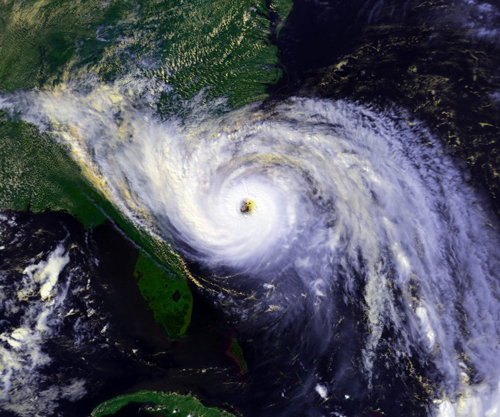
Thankfully, the Gibbes staff has hurricane preparation down to a science. The building was put to the test in 1989 when the powerful Category 4 Hurricane Hugo barreled into Charleston. While the Museum suffered power loss and minor flooding, the artwork was unaffected due in part to a fledgling disaster plan and the efforts of a dedicated staff. Over the past twenty-three years, the Gibbes Museum of Art Disaster Plan for Collections has been revised, added to, tested, revised again, tweaked, practiced, tightened, and updated with such regularity that all those involved are confident the Museum could once again weather a strong hurricane. Major hurricanes such as Andrew (1992) and Katrina (2005) have strengthened the national museum community’s commitment to disaster planning and placed great importance on preparedness, communication, and salvage techniques. Museums are now required to have a comprehensive disaster plan to achieve accreditation by the American Alliance of Museums.
So how do we prepare for a hurricane at the Gibbes? The Museum has a hurricane plan that goes into effect the moment a storm is predicted to hit the Charleston area. This plan exists in written form, and the details are reviewed with the entire staff at the beginning of each hurricane season. The plan contains general information about different types of disasters and how to respond as well as information specific to the collection including object inventories, emergency contacts (conservators, art shippers, storage facilities, archival suppliers), insurance policies, and art salvage techniques. The plan also details pre-storm activity which involves securing artwork on exhibit, moving objects away from all windows (we still have a few!) and covering storage racks and archival containers with plastic sheeting; much of the plastic is in place year round and simply needs to be pulled down and secured. One of the greatest hurricane threats besides wind is potential flooding and loss from a storm surge. To prepare for this possibility, we make certain all artwork is stored at least 6 feet off the floor, the recommended industry standard. Advance planning will always be a necessary component of protecting the museum; staff will work to secure the museum until it’s time to evacuate.
A major concern museums face after a hurricane is loss of power which affects climate control elements and can cause rapid fluctuation in temperature and humidity. Abrupt changes in relative humidity (RH) can result in dimensional alteration to hygroscopic materials (wood, ivory, etc.) resulting in warping and splitting of many sensitive materials that comprise the art collection. High RH (above 65%) can also cause mold growth and metal corrosion in as little as 48 hours! In order to mitigate the risk involved with loss of climate control and rising humidity, the Gibbes maintains powerful fans that can circulate air (and run via a generator if necessary) in the event of HVAC loss. Museum staff stock other necessary supplies including flashlights, batteries, blotting paper for drying wet art, cameras, pencils and inventory sheets for recording damage, brooms, mops, shovels, a weather radio, paper towels, boxes and cartons, first aid kits and more. These supplies are stored on a special disaster cart; a complete inventory of the disaster cart is conducted at the start of each season to make certain all supplies are present and accounted for!
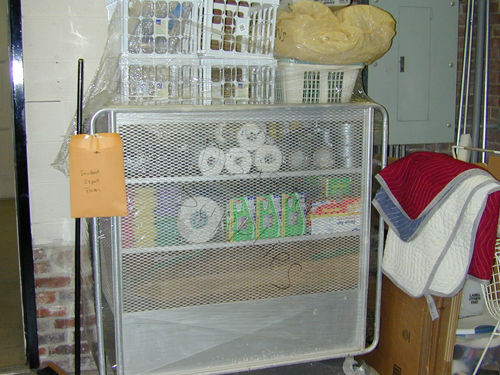
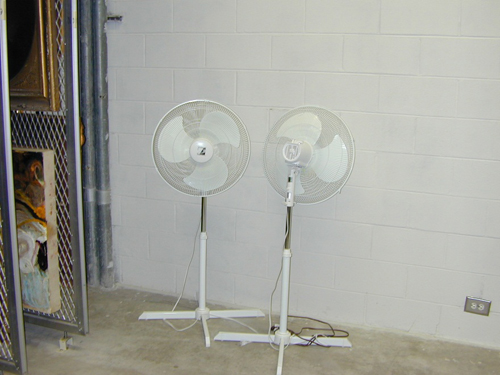
In addition to in-house disaster review, Gibbes staff also attends periodic disaster training workshops run through professional museum organizations. For example, in 2008 the South Carolina Federation of Museums (SCFM) staged a mock water disaster (with mock collection items) at Middleton Place Foundation for the workshop, Disaster Recovery for Museum Collections. Workshop participants spent the day learning how to respond to a water disaster and salvage and recovery techniques for paintings, furniture, textiles and a variety of objects. The workshop was led by Sharon Bennett, a veteran of Hurricane Hugo, who has taught numerous disaster preparedness workshops throughout the Southeast. A past-president of the Southeastern Museums Conference (SEMC), Sharon has served as the chair of the American Institute for Conservation Emergency Planning and Response Committee.
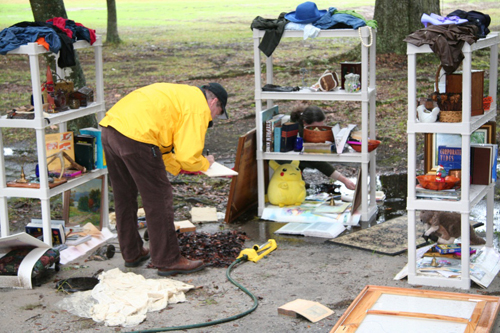
When participants arrived at the workshop they were greeted by three shelving units filled with wet art (framed prints and paintings), textiles, metal objects, ceramics, books, papers, and glass items. These objects were not just wet; they were thoroughly soaked (thanks to a very effective sprinkler and Mother Nature who added a little rain of her own). The water relocated some objects from their original shelf location to the ground and many were buried under a layer of Charleston’s sandy soil. It was a true disaster designed to mimic what an institution might face after a hurricane, flood, or man-made water catastrophe. After a long, wet, hectic day—sometimes frustrating, often satisfying, and overall informational and beneficial—participants left with a better understanding of how to create or update their own disaster recovery plan. By handling the various types of damaged collection items they gained experience in all aspects of a wet salvage and recovery efforts and left the workshop better prepared to write realistic and comprehensive response sections for their individual disaster plans.
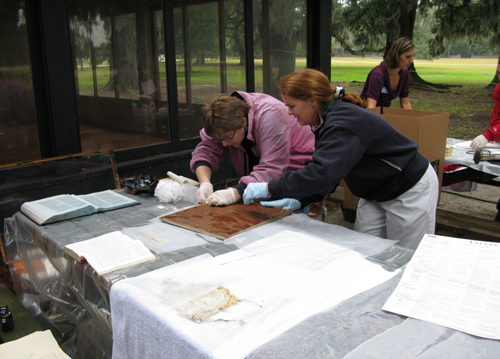
Emergencies can come in many forms from treacherous weather to mechanical breakdown not to mention potential hazards such as fire, water, mold, and even insects. Museums need to be prepared before a disaster happens. Disaster planning events such as the SCFM workshop provide the resources and time to take on this important task.
So as you keep a watchful eye on the tropics over the next several months, rest assured that Gibbes staff are doing the same and will continue to do their very best to protect and preserve Charleston’s stellar collection of art of the American South.
—Zinnia Willits, Director of Collections Administration, Gibbes Museum of Art
Published September 13, 2012

